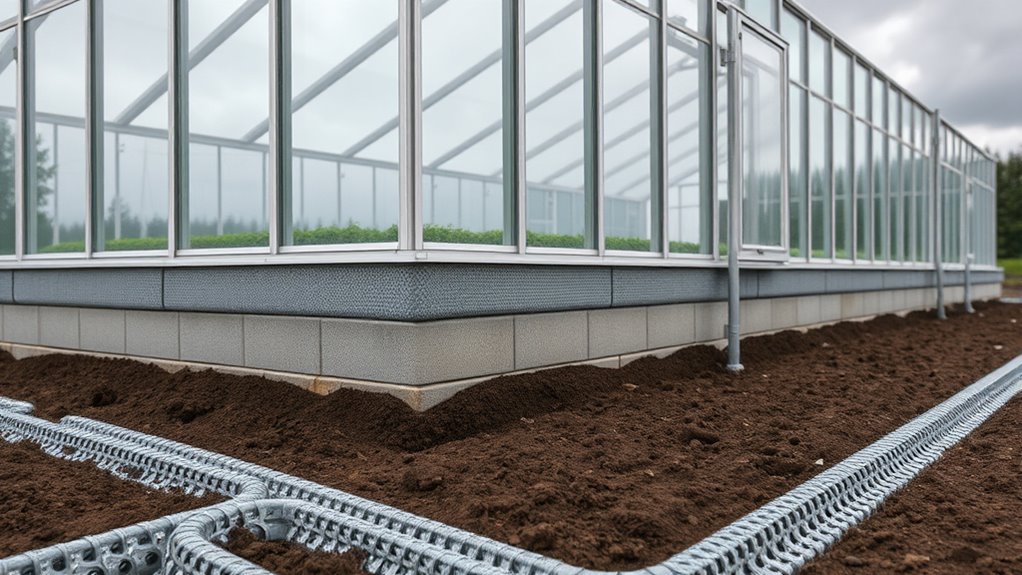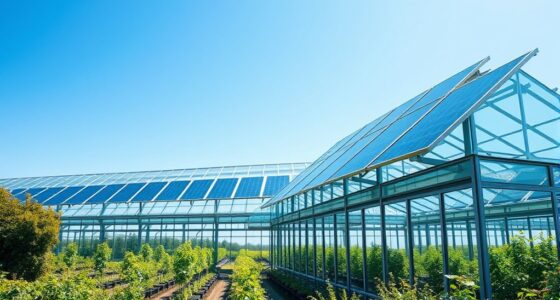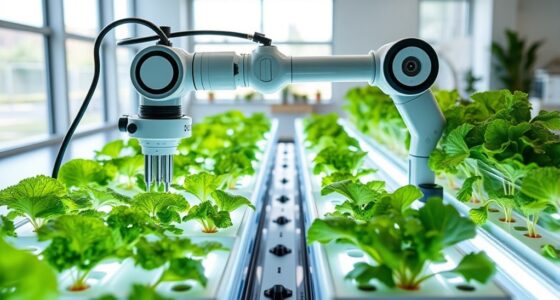To effectively drainage and flood-proof your greenhouse, guarantee your foundation encourages water to flow away and incorporate organic amendments or raised beds for better soil drainage. Install underground drainage systems like French drains and consider adding flood barriers or barriers around the perimeter for extra protection. Regularly inspect and maintain these systems, and elevate your greenhouse on a sturdy, well-drained base. Keep these strategies in mind to create a resilient, water-resistant environment that keeps your plants safe in any weather.
Key Takeaways
- Improve soil drainage by adding organic matter, raised beds, and installing underground drainage systems like French drains.
- Use flood barriers such as sandbags or reinforced walls around the greenhouse perimeter for immediate protection.
- Elevate the greenhouse on a well-drained foundation to reduce flood risk and facilitate water runoff.
- Regularly inspect and maintain drainage systems to prevent blockages and ensure effective water management.
- Combine soil improvements with external barriers and proactive measures based on weather forecasts for comprehensive flood-proofing.

Proper drainage and flood-proofing are indispensable steps to safeguard your greenhouse from water damage and guarantee healthy plant growth. When it comes to soil drainage, making certain your greenhouse’s foundation allows excess water to flow away efficiently is vital. Poor soil drainage can lead to water pooling around plant roots, increasing the risk of root rot and disease. To improve soil drainage, consider incorporating organic matter like compost or sand into your soil mix. These amendments loosen compacted soil, creating channels for water to escape. Raised beds are another effective solution, elevating plants above potential flood zones and facilitating better drainage. If your land is prone to heavy rain or flooding, you might also want to install underground drainage systems, such as perforated pipes or French drains, which direct excess water away from your greenhouse structure. Additionally, selecting appropriate soil types and implementing water management strategies can optimize drainage and reduce flood risks.
Flood barriers serve as a critical line of defense against water intrusion during heavy rains or flooding events. These barriers can be temporary or permanent and are designed to prevent water from breaching your greenhouse walls and foundation. For temporary flood barriers, sandbags or water-filled barriers can be quickly deployed when heavy rainfall is forecasted. They work by redirecting water away from vulnerable areas, giving you time to prepare or evacuate delicate plants. If your location is especially prone to flooding, investing in permanent flood barriers might be more effective. These could include reinforced walls or barriers made from durable materials like concrete or steel, specifically positioned around your greenhouse perimeter. Properly sealing entry points like doors and vents with weatherproof strips or waterproof sealants also enhances flood-proofing efforts.
Combining good soil drainage practices with sturdy flood barriers creates a thorough defense against water-related damage. Regularly inspecting your drainage systems guarantees they remain clear of debris, preventing blockages that can cause water to back up. Additionally, elevating your greenhouse on a stable, well-drained foundation reduces the risk of floodwaters seeping inside. Always keep an eye on weather forecasts and be prepared to implement your flood mitigation measures proactively. Proper drainage and flood-proofing aren’t one-time tasks; they require ongoing maintenance and vigilance to adapt to changing weather patterns. By taking these steps, you protect your investment, guarantee your plants thrive, and maintain a healthy, resilient greenhouse environment regardless of the weather outside.
Frequently Asked Questions
What Materials Are Best for Greenhouse Flood-Proofing?
You should use durable drainage materials like gravel, sand, or perforated pipes to guarantee effective flood-proofing. These materials help channel excess water away from the greenhouse. Incorporate flood-proofing techniques such as installing raised beds, barriers, or levees. Using waterproof sealants on the foundation also prevents water intrusion. Combining these methods and materials creates a reliable flood-resistant structure, protecting your greenhouse from potential water damage during heavy rains or flooding events.
How Often Should Drainage Systems Be Inspected and Maintained?
You should inspect your drainage system at least quarterly to catch any blockages or damage early. Follow a regular inspection schedule, especially after heavy rains or storms. During maintenance, clear debris, check for leaks, and guarantee pipes are unobstructed. Maintenance tips include flushing drains annually, tightening fittings, and replacing worn parts promptly. Staying proactive helps prevent flooding and keeps your greenhouse’s drainage system functioning efficiently year-round.
Can Flood-Proofing Methods Be Applied to Existing Greenhouses?
Think of flood-proofing your greenhouse as giving it a shield against storms. Yes, you can apply flood-proofing methods to existing greenhouses. Incorporate rainwater harvesting systems to redirect excess water and plant flood-resistant plants to absorb runoff. These adjustments strengthen your setup without starting from scratch, helping your greenhouse better withstand flooding and protect your valuable plants from unexpected deluges.
What Are the Costs Associated With Flood-Proofing a Greenhouse?
Flood-proofing your greenhouse costs depend on the methods you choose, but you should start with a solid cost estimation to stay within your budget planning. Expenses may include installing raised foundations, sealing entry points, and improving drainage systems. Expect costs to vary based on greenhouse size and materials used. By evaluating these factors early, you can better manage your budget and ensure effective flood protection without overspending.
Are There Eco-Friendly Drainage Solutions for Greenhouses?
Are eco-friendly drainage solutions worth considering for your greenhouse? Absolutely. You can utilize rainwater harvesting systems to reduce runoff and promote sustainability. Permeable paving allows water to filter naturally into the ground, minimizing erosion and flooding. These methods not only protect your greenhouse but also support eco-conscious practices. Wouldn’t you prefer a greener, more sustainable approach that benefits both your plants and the environment?
Conclusion
Think of your greenhouse as a delicate boat steering a river. Proper drainage and flood-proofing are your sturdy oars, guiding it safely through unpredictable waters. When you build these defenses, you’re not just protecting plants—you’re steering your lush vessel through storms, ensuring it stays afloat and thriving. With careful planning, you become the captain of this green sanctuary, mastering the currents of weather and water, and keeping your garden paradise secure amid life’s floods.










